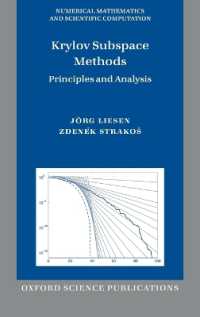- ホーム
- > 洋書
- > 英文書
- > Computer / General
Full Description
The transition towards exascale computing has resulted in major transformations in computing paradigms. The need to analyze and respond to such large amounts of data sets has led to the adoption of machine learning (ML) and deep learning (DL) methods in a wide range of applications.
One of the major challenges is the fetching of data from computing memory and writing it back without experiencing a memory-wall bottleneck. To address such concerns, in-memory computing (IMC) and supporting frameworks have been introduced. In-memory computing methods have ultra-low power and high-density embedded storage. Resistive Random-Access Memory (ReRAM) technology seems the most promising IMC solution due to its minimized leakage power, reduced power consumption and smaller hardware footprint, as well as its compatibility with CMOS technology, which is widely used in industry.
In this book, the authors introduce ReRAM techniques for performing distributed computing using IMC accelerators, present ReRAM-based IMC architectures that can perform computations of ML and data-intensive applications, as well as strategies to map ML designs onto hardware accelerators.
The book serves as a bridge between researchers in the computing domain (algorithm designers for ML and DL) and computing hardware designers.
Contents
Part I: Introduction
Chapter 1: Introduction
Chapter 2: The need of in-memory computing
Chapter 3: The background of ReRAM devices
Part II: Machine learning accelerators
Chapter 4: The background of machine learning algorithms
Chapter 5: XIMA: the in-ReRAM machine learning architecture
Chapter 6: The mapping of machine learning algorithms on XIMA
Part III: Case studies
Chapter 7: Large-scale case study: accelerator for ResNet
Chapter 8: Large-scale case study: accelerator for compressive sensing
Chapter 9: Conclusions: wrap-up, open questions and challenges








